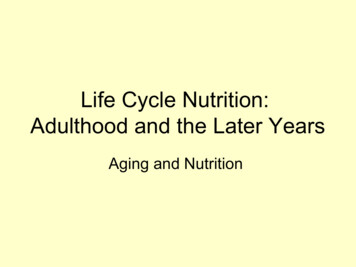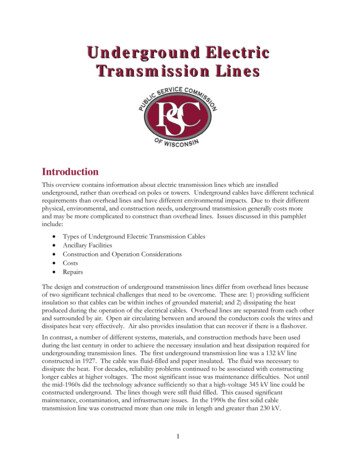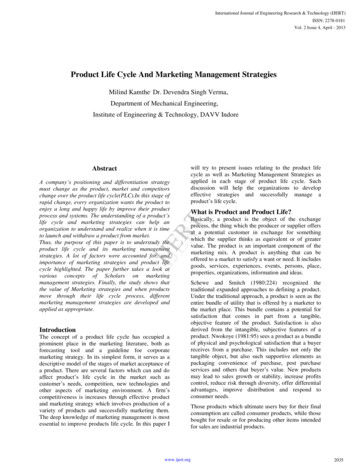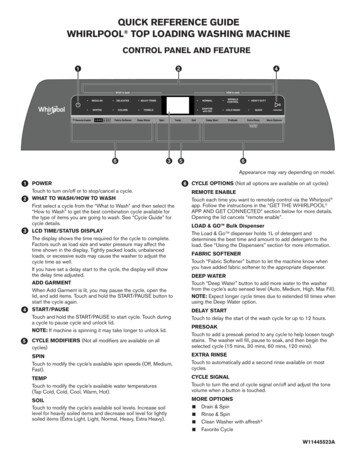
Transcription
Life Cycle Nutrition:Adulthood and the Later YearsAging and Nutrition
Nutrition for Older Adults One-fifth of the American population isover 65. Older adult defined as anyone over 50
Adult Nutritional Requirements18-51 yearsRelated to: Cessation of linear growth Increasing sedentary lifestyle Establishment of chronicdisease risk factors Adjustment to chronic stress
Nutrition Risks of Adults Macronutrientexcesses andmicronutrientdeficiencies Diminished activityand high fat intake Stress-relatedeffects on immunefunction
Nutrient Requirementsof the Older Adult Nutrient-dense dietDecreased energy needsHigh-quality proteinHydrationVitamins and mineralsAdequate fiber from foods,not supplements
Age-Related Changes in sequence Energy muscle massWeight Gain unlessactivity increased Protein amino acidpoolLoss of musclemass and functionalcapacity Folate, B12, B6 absorptiveefficiency plasmahomocysteine,neurological damage Vitamin ECumulativeoxidativedamageImmuneincompetence Ca, Mg. VitaminD bioavailabilityAccelerated boneloss;immunoincompetenc
Comparison of AdultNutrient nDCalciumg31-50 yrs51-70 yrs70 yrs
Nutrition and Longevity Observation of Older Adults– Healthy Habits Sleeping regularly and adequately Eating well-balanced meals, including breakfast,regularly Engaging in physical activity regularly Not smoking Not using alcohol, or using it in moderation Maintaining a healthy body weight
Nutrition and Longevity Observation of Older Adults– Physical Activity Many benefits including lower weight, greater flexibility,increased endurance, better balance and health, and alonger life span Regular physical activity can prevent or delay the decreasein muscle mass and strength that occur with age. Active people benefit from higher energy and nutrientintakes. Start easy and build slowly Check with physician
Nutrition and Longevity Manipulation of Diet– Energy Restriction in Animals Shown to prolong life Shown to delay onset of or prevent disease– Energy Restriction in Human Beings Applying results in animal studies to human beingsis problematic. Moderation of energy intake may be valuable.
Adult Nutritional Requirements51 yrs and older Related to:–Physical, emotional, and physiologicalchanges affecting appetite and ability toeat–Medications that may interactwith nutrients–Diseases with specific nutritionalrequirements
The Aging Process Physiological, psychological, social, andeconomic changes that accompany agingaffect nutritional status. Everyday stress can influence physical andpsychological aging. Stressors elicit the body’s stress response. Physical stressors include alcohol and drugabuse, smoking, pain and illness. Psychological stressors include exams, divorce,moving, and the death of loved ones. Malnutrition is common.
Nutrition Risks of Adults :Psychosocial Factors Living aloneDepressionAnxietyLong-standing food habitsEconomic considerations
Nutrition Risks of Adults : : PhysicalFactors Loss of teeth Loss ofneuromuscularcoordination Impaired hearing andvision Maculardegeneration Physical discomfortLoss of muscle massArthritisDiminished sense oftaste and smell Anorexia
Percentage of Malnutritionin Long-term Health Facilities Contributing FactorsPercentage of 0Maln– Sensory losses– Sarcopenia– Decline indigestive/absorptiveefficiency– Stress– Disease– Medications30
Factors Affecting Nutrient Use Organs less efficientDecreased kidney functionDecreased gastric motilityMalabsorptionDecreased hormones
The Aging Process Physiological Changes– Body Weight Two thirds of the adults in the U.S. are overweightor obese. Older adults with low body weight may beunprepared to fight illness and disease.– Body Composition Sarcopenia is the loss of muscle mass. Nutrition and exercise play a role in maintainingmuscle mass.
The Aging Process Physiological Changes– Immune System Compromised immune systems can occur with age. Incidences of infectious disease increase– GI Tract Slower motility resulting in constipation Atrophic gastritis impairs digestion and absorption ofnutrients due to stomach inflammation, bacterial overgrowth,and a lack of hydrochloric acid and intrinsic factor. Dysphagia is defined as difficulties in swallowing and canresult in nutritional deficiencies.
The Aging Process Physiological Changes– Tooth Loss Tooth loss and gum disease can interfere with food intake. Edentulous is lack of teeth. Conditions that require dental care––––––Dry mouthEating difficultyNo dental care in 2 yearsTooth or mouth painAltered food selectionsLesions, sores, or lumps in mouth Ill-fitting dentures
The Aging Process Physiological Changes– Sensory Losses and Other Physical Problems Vision problems can make driving and shoppingdifficult. Taste and smell sensitivities may diminish.
The Aging Process Other Changes– Psychological Changes Depression and loss of appetite commonly occur together. Support and companionship of family and friends are helpful.– Economic Changes Older adults have lower incomes and are at risk for poverty. Only 1/3 receive aid from federal assistance programs.– Social Changes Loneliness is directly related to low energy intakes. Malnutrition is common.
Energy and Nutrient Needs ofOlder Adults There are many nutrient concerns foraging adults. Supplements are not routinelyrecommended. Nutrient needs and health needs arehighly individualized.
Energy and Nutrient Needs ofOlder Adults Water– Dehydration increases risks for urinary tractinfections, pneumonia, pressure ulcers,confusion and disorientation.– Fluid needs are not recognized.– Mobility and bladder problems– Water recommendations: at least 6 glassesper day
Energy and Nutrient Needs ofOlder Adults Energy and Energy Nutrients– Energy needs decrease by around 5% per decade.– Protein to protect muscle mass, boost the immunesystem, and optimize bone mass– Carbohydrate for energy– Fiber and water to reduce constipation– Fat to enhance flavors of foods and provide valuablenutrients
Energy and Nutrient Needs ofOlder Adults Vitamins and Minerals– Vitamin B12 from fortified foods and supplements isespecially needed for those with atrophic gastritis.– Vitamin D from fortified milk and sunshine is neededto prevent bone loss.– For those who avoid milk and milk products, calciumcan be obtained from fortified juices, powdered milk,or supplements.– Iron from red meats consumed with vitamin C-richfoods
Energy and Nutrient Needs ofOlder Adults Nutrient Supplements– Vitamin D and calcium for osteoporosis– Vitamin B12 for pernicious anemia– Iron
Nutrition-Related Concerns ofOlder Adults Adults over 65 have many problems thatmight be preventable through goodnutrition. There is a strong need to solve vision,arthritis, and brain related problems.
Major Nutrition-Related Issuesof Older Adults nt interactionsFood-induced malnutritionAlzheimer’s disease
Nutrition-Related Concerns ofOlder Adults Vision– Macular degeneration is a deterioration of themacula (center of the retina) area of the eyethat leads to vision problems and blindness. Antioxidants, zinc, leutein, zeaxanthins, andomega-3 fatty acids are preventative factors. Total fat intake may be a risk factor.
Nutrition-Related Concerns ofOlder Adults Arthritis– Osteoarthritis (also called degenerativearthritis) Risk factors include age, smoking, BMI at 40, andlack of hormone therapy in women. Painful deterioration of the cartilage in the joints Associated with overweight
Nutrition-Related Concerns ofOlder Adults Arthritis– Rheumatoid Arthritis Immune system attacks bone coverage Omega-3 fatty acids may reduce joint tendernessand motility. Vitamin C, vitamin A, and carotenoids asantioxidants often help.
Nutrition-Related Concerns ofOlder Adults Arthritis– Gout Uric acid deposits in the joints Purines are converted to uric acid. There are increased uric acid levels when meatand seafood are consumed. Milk products lower uric acid levels.
Nutrition-Related Concerns ofOlder Adults Arthritis– Treatment Relief from discomfort and improve mobility No cure Alternative therapies such as glucosamine andchondroitin may help but this is not confirmed. Drugs and supplements may affect nutritionalstatus.
Nutrition-Related Concerns ofOlder Adults The Aging Brain– Nutrient Deficiencies and Brain Function Neurotransmitters need precursor nutrients. Senile dementia Neurons diminish as people age.
Nutrition-Related Concerns ofOlder Adults The Aging Brain– Alzheimer’s Disease Abnormal deterioration of the brain Free radicals and beta-amyloid Senile plaques and neurofibrillary tangles develop in thebrain. Acetycholine breakdown may affect memory. Drugs are useful. Maintaining body weight is important; Alzheimer’s patientsmay forget to consume foods.
This is cerebral atrophy in a patient with Alzheimerdisease. The gyri are narrowed and the interveningsulci widened, particularly pronounced toward the
Brain of an 82 y.o. male (Left) vs 36 y.o. male (Right)Physiologic atrophy due to age-related diminished blood supply
Hyperphosphorhlated tau ptnubiquitin, MAPS*, Amlyoid beta ptnDisplace Encircle NucleusALZNeurofibrillary Tangles: Paired Helical Filaments* MAPS - microtuble-associated protein
Relationship of Disease Risk Factorsto Nutrient Intakes in the elderlyRisk FactorDiseaseExcessDeficiencyInsulinResistanceType II DiabetesIDDMfat, refinedsugars, energychromium, zinc,vitamin E, B6DyslipidemiaAtherosclerosisCHDsat fat, total fat,cholesterol,energyfolate, B12, otassiumCa, Mg, ω3 to ω6fatty acidsExcess BodyFatCHD, IDDM,Cancer, HT,osteoarthritisenergy, idants,Cancer, Infectious fat,Diseaseω6 to ω3 FAvitamin Cfolate, vitamin A,Zn, Fe, B6, vitaminC
Food Choices and Eating Habitsof Older Adults Older people benefit from the socialinteraction and the nutrients providedthrough food assistance programs. Older adults should purchase foodscarefully and prepare foods creatively.
Food Choices and Eating Habitsof Older Adults Food Assistance Programs– Congregate meals are group settings atcommunity centers.– Meals on Wheels is a home-delivered mealprogram.– The Senior Farmers Market Nutrition Programallows low-income older adults to exchangecoupons for fruits, vegetables, and herbs.
Food Choices and Eating Habitsof Older Adults Meals for Singles– Foodborne Illness Greater risk in older adults If severe, can cause paralysis, meningitis, or death– Spend Wisely Buying proper quantities Buy foods with longer shelf life – ultrahigh temperature (UHT)for milk products– Be Creative Use fresh foods for different recipes. Dine with others. Freezing meals
Community Programs for the OlderAdult Can Make a Big Difference Companionshipand healthymeals are agoodcombination.Hewlings/MedeirosNutrition: Real People, Real Choices 1e17.47 2009 Pearson Education, Upper Saddle River, NJ 07458 AllRights Reserved.
Nutrient-Drug Interactions Both prescription and nonprescription(over-the-counter) drugs may havenutrition related consequences. Individuals need to consult with all of theirphysicians and pharmacists to avoidharmful drug interactions.
The Actions of Drugs Modifies one or more of the body’sfunctions Desirable and undesirable effects
The Interactions between Drugsand Nutrients Altered Food Intake– Altering appetite– Interfering with taste and smell– Inducing nausea or vomiting– Changing oral environment– Causing sores or inflammation of the mouth
The Interactions between Drugsand Nutrients Altered Nutrient Absorption– Changing acidity of the digestive tract– Altering digestive juices– Altering motility of the digestive tract– Inactivating enzyme systems– Damaging mucosal cells– Binding nutrients
The Interactions between Drugsand Nutrients Altered Drug Absorption– Changing acidity of the digestive tract– Stimulating secretions of the digestive juices– Altering rate of absorption– Binding to drugs– Competing for absorption sites
The Interactions between Drugsand Nutrients Altered Metabolism– Acting as structural analogs– Competing with each other for metabolicenzyme systems– Altering enzyme activity and contributingpharmacologically active substances
The Interactions between Drugsand Nutrients Altered Nutrient Excretion– Altering reabsorption in the kidneys– Displacing nutrients from their plasma proteincarriers Altered Drug Excretion– By changing acidity level of the urine
The Inactive Ingredients inDrugs Other ingredients in drugs may include sugar,sorbitol, lactose, and sodium. Sugar, Sorbitol, and Lactose– Sugar may be a problem for diabetics– Sorbitol may cause diarrhea– Lactose can be a problem for those with lactoseintolerance Sodium can be found in antibiotics and antacids
Vitamin and MineralSupplements
Vitamin and MineralSupplements Many people take dietary supplements fordietary and health insurance. Some take multinutrient pills daily. Others take large doses of single nutrients. A valid nutrition assessment by professionalsdetermines the need for supplements. Self-prescribed supplementation is not advised. There are many arguments for and againstsupplements.
Arguments for Supplements Correct Overt DeficienciesSupport Increased Nutrient NeedsImprove Nutrition StatusImprove the Body’s DefensesReduce Disease Risks
Arguments for Supplements Who Needs Supplements?– People with nutritional deficiencies– People with low energy intake – less than1600 kcalories per day– Vegans and those with atrophic gastritis needvitamin B12– People with lactose intolerance, milk allergies,or inadequate intake of dairy foods
Arguments for Supplements Who Needs Supplements?– People in certain stages of the life cycle Infants need iron and fluorideWomen of childbearing age need folatePregnant women need folate and ironElderly need vitamins B12 and D– People with diseases, infections, or injuries, andthose who have had surgery that affects nutrientdigestion, absorption or metabolism– People taking medications that interfere with thebody’s use of specific nutrients
Arguments againstSupplements ToxicityLife-Threatening MisinformationUnknown NeedsFalse Sense of Security
Arguments againstSupplements Other Invalid Reasons:– Belief that food supply and soil contain inadequatenutrients– Belief that supplements provide energy– Belief that supplements enhance athletic performanceor lean body mass without physical work or fasterthan work alone– Belief that supplements will help a person cope withstress– Belief that supplements can prevent, treat or cureconditions Bioavailability and Antagonistic Actions
Selection of Supplements What form do you want? What vitamins and minerals do you need?– Do not exceed Tolerable Upper IntakeLevels.– Be careful about greater that 10 mg of iron.
Selection of Supplements Are there misleading claims?–––––––Ignore organic or natural claims.Avoid products that make high potency claims.Watch fake preparations.Be aware of marketing ploys.Be aware of preparations that contain alcohol.Be aware of the latest nutrition buzzwords.Internet information is not closely regulated. What about the cost?– Local or store brands may be just as good asnationally advertised brands.
Regulation of Supplements Nutritional labeling for supplements is required. Labels may make nutrient claims according tospecified criteria. Labels may claim that lack of a nutrient cancause a deficiency disease and include theprevalence of that disease. Labels may make health claims that aresupported by significant scientific agreement.
Product nameStatement of identityDescriptive termsif product meetscriteriaContents or weightSupplement factspanelThe suggested doseThe name, quantityper tablet, and “%Daily Value” for allnutrients listed;nutrients without aDaily Value may belisted below.All ingredients must belisted on the label, but notnecessarily in the ingredientlist nor in descending orderof predominance; ingredientsnamed in the nutrition panelneed not be repeated here.Name and address ofmanufacturerStepped ArtFig. H10-1, p. 365
Regulation of Supplements Labels may claim to diagnose, treat, cure, orrelieve common complaints but not make claimsabout specific diseases. Labels may make structure-function claims ifaccompanied by Food And Drug Administration(FDA) disclaimer.– Role a nutrient plays in the body– How the nutrient performs its function– How consuming the nutrient is associated withgeneral well-being
Nutrition and Longevity Observation of Older Adults – Physical Activity Many benefits including lower weight, greater flexibility, increased endurance, better balance and health, and a longer life span Regular physical activity can prevent or delay the










